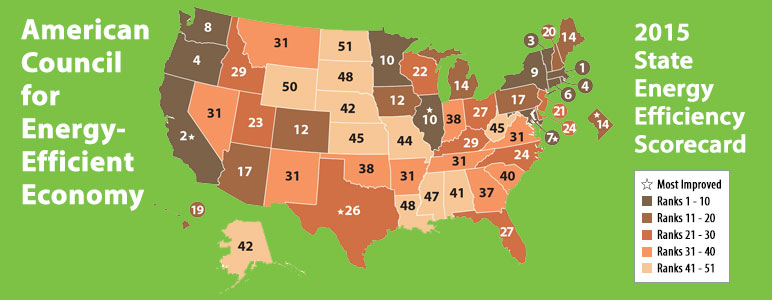


There’s no big surprise in Massachusetts earning the top spot for a fifth consecutive year in the State Energy Efficiency Scorecard issued by the American Council for an Energy-Efficient Economy (ACEEE).
With a focus on capturing all cost-effective energy efficiency through utility ratepayer-funded programs, combined with strong state programs, buildings codes and deployment of combined heat and power (CHP) technology, the commonwealth’s electricity load has leveled off, and is even decreasing, as the economy continues to grow. However, with other states learning from the best practices of those with strong efficiency policies and programs and potentially leapfrogging ahead, the state may be on the path to a major upset in 2016.
"Competition For Top Energy-Efficient States Gets Tighter" originally published at Cleantechnia.
ACEEE’s Energy Efficiency Scorecard serves as a platform for national discussions about how to achieve energy and carbon reduction goals simultaneously, with annual and lifetime benefits far exceeding costs. Massachusetts earned 44 points in the 50-point ACEEE scorecard, compared to California’s 43.5. Third-place Vermont achieved 39.5 points whereas when the scoring began in 2006, it tied with Connecticut and California for the most energy efficient state title.
A closer look
While ACEEE reports Massachusetts’ electricity savings achievement level is at 2.5%, that figure represents only the savings goal set in its energy efficiency plan. In fact, in 2014, Massachusetts achieved electricity savings of 2.7% of sales by offering a variety of incentives and financing programs to encourage investments. Further, Massachusetts’ 2014 annual gas consumption was reduced by 1.33% of sales, compared to the goal of 1.15%. However, second-place California’s scoring is inching closer to Massachusetts, and this year the Golden State also received a “most improved” designation.
Comparing California to Massachusetts can be difficult, given the inherent differences. For example, California’s population is nearly six times that of Massachusetts. From my house in Boston I can get to New York State in about two hours. I understand that it takes anywhere from 12 to 16 hours to drive from San Diego to the Oregon border (not accounting for traffic). If we begin to compare the two states in the ACEEE ranking, we can see some striking differences.
Thanks largely to the Massachusetts Green Communities Act, it won all possible points in the utilities category, which encompasses policies and programs operated by or in partnership with utility program administrators. California, meanwhile, achieved 14 of 20 points in this category. In contrast, California won perfect scores in nearly all of the other categories: transportation, building codes, CHP, state-led initiatives and appliance standards. In these categories, Massachusetts achieved varied success in capturing points, with a low of zero for appliance standards.
The two states are neck and neck on the total scoring, but are achieving those points in completely different ways. What would happen if Massachusetts adopts California’s stronger tailpipe emissions and appliance standards? And what if California begins to achieve stronger utility ratepayer-funded efficiency goals closer to the Massachusetts model? Of course, in this scenario, we’re not talking about the other 49 contenders (including Washington, D.C.) – any of whom could catapult past these two top-tier states.
Another variable in the race for #1 is the scoring system. ACEEE is constantly evolving the scoring to accommodate new technologies and practices, to capture the full possibility of opportunities to achieve savings. Will there ever be a perfect score? If there is, then how will we know the extent that future perfect-score states could be improving?
Hot topic of discussions
In my professional circle, I regularly hear speculation about how the next scorecard ranking will pan out. When we have this simple platform, we can see how to learn from each other to achieve even greater savings moving forward. The differences between states’ energy efficiency performance levels represents a huge opportunity to fill the gap in performance so that we can all enjoy the benefits of a lower overall cost of energy, less reliance on carbon-emitting fossil fuels, improved energy reliability and increased local job growth.
Recently, in Minneapolis during a discussion among national energy efficiency experts talking about the scorecard, one colleague from another state jokingly shook his fist in my direction while exclaiming, “We’ll get you, Massachusetts!”
My reply? “I hope you do.”
Elizabeth Glynn is CSE’s Northeast Regional Manager and a voting member of the Massachusetts Energy Efficiency Advisory Council.

